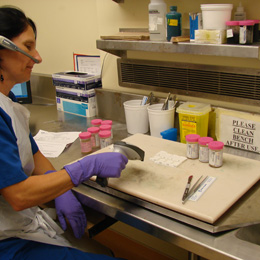 When the specimen first arrives in the lab, it often comes straight from the operating room or biopsy clinic.
When the specimen first arrives in the lab, it often comes straight from the operating room or biopsy clinic.
It's a piece of fresh tissue that we first document into our laboratory information system (LIS) to create a unique identifier for each specimen, from each patient.
The first thing the surgical pathology team does is review all the patient information provided and make sure that the specimen collected is appropriate for the services required. We want to be sure we identify and resolve any issues that might impact our ability to perform testing services for our patients.
We then prioritize the case and begin our pathology examinations.
For some tissues from the operating room, the first step is biobanking, which means a representative sample of normal and abnormal tissue is frozen for future research use.
For all tissues, the next step is placement in a chemical called formalin. Formalin stops the biological breakdown of the tissue components, preserving them for all future studies.
At this point, it is the job of the Pathologist's Assistant to look at the specimen received. Using voice recognition software that is integrated with our LIS, they describe what the specimen looks like, cut it open (if a large piece of tissue), measure typical and atypical features observed, and selectively cut representative pieces of tissue for processing in the next stage of the process.
Some of the things that are most important to cancer patient management are how big the tumour is, how far the tumour is from the surgical margins, whether more than one tumour is present, if adjacent lymph nodes are affected, and the depth the tumour has penetrated into the normal tissue.
Another reason we sample the specimen in various locations is to see what other normal or abnormal attributes might be present. We need to tell physician, and patient, about their primary disease as well as any other types of underlying disease going on.
The pieces of tissue selectively cut will be placed into the uniquely labelled cassettes, and documented into the LIS. Now the cassettes are ready for tissue processing.
